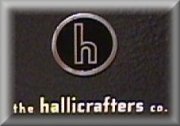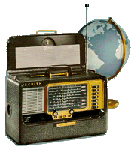

Reprinted from the book RADIOS BY hallicrafters, a Schiffer publication, Chuck Dachis; author


Reprinted from the book RADIOS BY hallicrafters, a Schiffer publication, Chuck Dachis; author
How It All Began
In Boston, Massachusetts, during the spring of 1899, Hallicrafters founder William J. Halligan was born. It would be another thirty-two years before he or anyone else new how crucial a role he would play in the development of radio technology. As a youngster, Bill was fascinated with the new technology of radio telegraphy, anxiously gleaning information on the subject from the latest scientific journals and the few books that were available. His first real job, when he was sixteen,was as a wireless operator on a excursion boat in the Boston area. Bill spent the next several years as a wireless operator on a number of ships, serving sea duty on a mine-layer off the coast of Scotland during World War I.
After the war Bill attended electrical engineering school at Tufts College and then at West Point, leaving West Point in 1922 to marry Kate Fletcher. He took a job as a reporter on a Boston newspaper, and also wrote articles for the 'new' American Radio Relay League. In 1924 he became sales manager for his old friend Toby Deutschmann, who was distributing imported radio parts to American radio manufacturers. By 1928, Toby's business was booming. Bill decided to strike out on his own as a manufactures' representative, selling parts directly to the radio makers. In 1928. this decision led Bill to Chicago; most of the radio manufactures were located there. For three years his business did well, but in 1931 his clients were hit hard by the Depression, going bankrupt faster than the wind was blowing off the lake!
The First Hallicrafters Radios
Continuously active in building and operating his own Ham radio station, but unable to sell enough parts to pay the bills, Bill was inspired to build handcrafted Ham radio receivers, which had not existed previously in any commercial inventory. He made just a few at a time, using the highest quality parts with no mass production.
He called his new business "The Hallicrafters". The name was chosen as a composite of the two words: "Halligan" and "handcrafted".Bill adopted the creed "Handcraft Makes Perfect", and it was used in the first logo of the new enterprise in late 1932 A Few set were built , the S1 through the S3, at an old manufacturing plant at 417 North State Street.
Immediately the young Hallicrafters company was beset with problems. Most of the "Hams" these new radios were designed for hadn't yet recovered from the Depression, and didn't have the money to buy them. As if this wasn't enough, RCA came down hard on Hallicrafters for patent infringements, insisting that no more radios could be built until they granted Bill a license - which they had no intention of doing!
Bill didn't give up. Procuring as many
orders for his radios as possible, he contracted with a licensed manufacturer
to build them in small production runs of fifty or a hundred sets. He had
to use the orders themselves for collateral, an arrangement that at best
was
very limiting. What Hallicrafters needed was a license to build under RCA
patents. In 1933 Silver-Marshall Inc, went into bankruptcy, and Bill saw
an opportunity to get his coveted license. A deal was engineered; Bill
and Hallicrafters took over Silver-Marshall Inc., re-naming it the "Silver-Marshall
Manufacturing Company" and operating it from the State Street address.
This relationship was also plagued with financial problems, and ended in
late 1934. Bill was released from his obligations to Silver-Marshall with
the help of Ray Durst, a customer credit manager for the Echophone Radio
Company. Echophone was also in financial trouble, for all practical purposes
out of business. They had a 50,000 square foot plant at 2611 Indiana Avenue,
and a good license. Bill struck a deal with the owner of Echophone and
the two companies merged, with Hallicrafters being the dominant partner.
Ray Durst became vice president of Hallicrafters. During the first few
months the company did contract work for other radio manufacturers and
large mail-order houses in order to build its cash reserves. In late 1935
they started producing their own line of communications receivers, which
we are all familiar with. The SX-9 "Super Skyrider" was the first model
to be produced in significant quantities. The company logo was changed.
Hallicrafters in the Late '30s
Hallicrafters' policy was to build
a quality product with all the state-of the-art advances and features,
at a price that was affordable. With this policy and good management, they
pulled themselves up by their bootstraps. By 1938 Hallicrafters was the
most popular manufacturers of communications receivers in the US, and were
doing business in eighty-nine other countries. Bill decided on another
policy: that as new features and technical advances were made, Hallicrafters
would bring out new models, rather than just upgrade the same basic model.
This explains the profusion of different models, which in the three-year
period from 1936 to 1938 had reached twenty·three. Until 1938 the
production was limited to receivers and associated accessories; it was
time to produce transmitters. The job of designing the new product line
belonged to the newly hired Bob Samuelson, who was responsible for the
designs of the HT-1 through the HT-14, and would shortly become the company's
chief engineer.
Hallicrafters & World War II
The onslaught of World War II took
the U.S. by surprise. There was a shortage of military radio equipment
and tremendous government demand for Electronic equipment of all types.
Many of the existing Hallicrafters products and designs were pressed into
military service. The company geared up for wartime production, and was
responsible for many new designs and innovations. Probably the best-known
of these were the HT-4 (BC-610) and related equipment used in the SCR-299.
Production of Ham radio gear and related items was all but suspended until
1945.
Post-War Hallicrafters
By August of 1945, the war was over, and so were wartime production and most government contracts. It was time again to produce ham radio equipment. A new line of consumer electronics was needed to satisfy a public hungry for products they had gone without for over five years.
The old plant at 2611 Indiana Ave, had served Hallicrafters well during the war years, but the company needed a modern image for their facility and product line in the postwar period. A new plant was designed and built at 4401 West 5th Avenue (5th and Kostner) that would be the company's home for the next twenty years. The products were given a 'modern' look with the help of Raymond Loewy, a well-known industrial designer of the time. One of the first postwar sets produced in the new facility was the 5-38. The logo was again changed, this time to the familiar "Circle H.
Production also began on the new line of consumer electronics, including radio phonograph units of all shapes and sizes, AM/FM receivers, clock radios in brightly colored Bakelite cases, and television receivers (the first being the T-54). Many of the consumer products bore the name "Echophone," which had been all but forgotten by that time. Competition was stiff in the consumer electronics field, and this Hallicrafters line never really took hold, although stayed in production until the late 1950s. Even so, the company was doing better than ever, was employing 2,500 people by 1952.
The 1950s were very successful for the company. Bill's son, Bill Jr., and possibly other family members were involved in the operation. The United States' focus during the 'fifties was civil defense, so many Hallicrafters products from this period bore names like "Civic Patrol" and "Defender." Some of the Ham radio products became classics, like the HT-32 and SX-101 (1957). Much of this equipment is still in use today and is sought after by nostalgia buffs and collectors.
By 1958 Bill, Sr. wanted to retire, and the company was sold. Little was known about this transaction, but it apparently failed and the Halligans resumed control a short time later. In 1963 Hallicrafters purchased Radio Industries, Inc. of Kansas City, running it as a subsidiary. Radio Industries produced many of the Ham radio accessories and some
major equipment like the HT-45 "Loudenboomer."
The Halligans continued operations until about 1966, when the company was
sold to the Northrop Corporation. This ended forever the Halligans involvement
in Hallicrafters.
The End of Hallicrafters
Northrop moved the company to a new plant at 600 Hicks Road in Rolling Meadows, IL, and modified the logo again. While a subsidiary of Northrop, Hallicrafters produced Ham radio products for a few more years, but the main function was producing para-military equipment in Northrop's defense systems division, much of it in El Paso, TX. For all practical purposes the last Ham radio item produced was the FPM-300 in 1972, and a few accessories through 1974. There were also some CB units and portable 'jam box' type AM/FM/SW sets of Japanese origin released under the Hallicrafters name. At this point, Northrop turned Hallicrafters over to its partner, Wilcox.
The annual sales of Hallicrafters had been falling off sharply since 1970. On December 4, 1975, Wilcox sold the company to the Braker Corporation of Dallas, Texas, represented by Darrell Fletcher. Braker packed up fourteen semi-trailer loads of Hallicrafters records and parts and moved the company to Grand Prairie, Texas. They set up shop there, with several former Hallicrafters employees of the late '60s and '70s who relocated to Texas. A few more CB's and various portable radios of Japanese and Taiwanese origin were released, but Braker began to suffer severe financial difficulties.
Around 1980 Braker ceased doing business, and Hallicrafters along with it.
On August 24th 1979 Clarence E. Long (a business acquaintance of Fletcher's from Miami) engineered a purchase of the name, logos and what was left of the company. A new corporation, called Hallicrafters International, was set up in Miami; it also had international trademarks.
Long set up shop and hired a large staff in anticipation of receiving large government contracts to build paramilitary radios for the armed forces. The new Hallicrafters International had to prove to the government they could handle the contracts as well as the old firm had. Something went wrong, however; Long's plans failed to be approved, and Hallicrafters lost the contracts.
In the early 2980s Long set up a plant somewhere in the New England States, and also had convinced several well-known people in other parts of the country to join the company. Among them was Tom Lott, who had worked for Bell Laboratories for many years and was responsible for research and development of some of the first transistors in the early 1950s.
Despite all this activity, Long was in serious financial and legal trouble. He declared bankruptcy on June 1, 1988 in San Antonio Texas. All of his property-including the Hallicrafters name, logos, and whatever records were saved-were made property of a court-appointed trustee.
Since this time, the Hallicrafters name has not been used, and, for all practical purposes, is nonexistent.